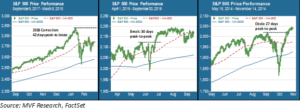
It hasn’t been quite the V-shaped recovery of many pundit prognostications. The S&P 500 briefly entered technical correction territory last month, and flirted ever so coquettishly with the 200-day moving average, a key technical trend variable. The ensuing relief rally has seen a couple peaks, but is still climbing the wall back to the record close of 2872 reached on January 26. A month and a half may not seem like a long time – and it’s really not a long time, in the great scheme of things. But other recent pullbacks have done a better job at channeling their inner Taylor Swifts to “shake it off.” The chart below show the pace of the current recovery (leftmost diagram) compared to the brief pullbacks experienced after 2016’s Brexit vote (middle) and the mini-freakout over Ebola in 2014 (right).

So at 42 days, we’re a bit behind the brisk pace of the Brexit (30 days) and Ebola (27 days) pullback-recovery events. But it’s not too much of a stretch to imagine the S&P 500 finding itself scaling the rest of that wall to 2872 in the not so very distant future. Over the course of the current recovery, investors have learned to build an impressive immunity to what one might consider to be bad news. In a sense this is an acquired habit, courtesy of the world’s major central banks.
It Was Just Nine Years Ago Today, Ben Bernanke Taught the Band to Play
Speaking of the “current recovery,” today is its nine year anniversary! Three cheers for the bull. On March 9, 2009 US equity markets hit rock-bottom, more than 50 percent down from their previous highs in the largest market reversal since the Great Depression. Investors in early 2009 were catatonic – many who had managed to keep their heads during the freefalls in September and October of the previous year finally capitulated in March, fearing there was potentially no bottom for risk assets.
Those who held off the demons of fear one last time were rewarded mightily as stocks found solid ground and began the long trek back. But it was not exactly easy street for those first tentative years. 2010 witnessed a handful of significant pullbacks and lots of angst. In 2011 the market flirted with bear territory (20 percent or more down) when the Eurozone crisis accelerated and the US Congress came ever so close to defaulting on the national debt. Other potential black swans lurked in the following years, from government shutdowns to the crash in oil prices to fears of a hard landing in China.
But as each news cycle came and went investors learned to stop worrying. Credit for this learned behavior can confidently be laid at the feet of Ben Bernanke, Mario Draghi, Haruhiko Kuroda and Janet Yellen, along with a supporting cast of dovish policymakers in their respective central banks. The “central bank put” was solidly in the money and increased in value throughout the recovery, even as the US Fed started to lead the way out of monetary Eden as it ended quantitative easing and began to raise rates. The investor calculus was simple: things will work out, and if they don’t, the banks will step in and bail us out. This way of thinking finally led to that unreal calm in the markets in 2017. Even the wackiest of political shenanigans failed to make an imprint on investors trained to embrace the Panglossian assurance of the best of all possible worlds for risk assets.
O Brave New World, That Hath Such Creatures In It
If the central bank put is the magic formula for maintaining calm, what to make of the tea leaves from recent statements by Yellen’s successor, Jerome Powell? The new Fed chair has been largely unimpressed by the recent market volatility and appears to see no reason for soothing bedtime stories to global investors. That should be a good sign: if the economy is doing well on its own, then markets should be able to take in stride the upward movement in interest rates and inflation that one would expect to follow from rising corporate sales and earnings. Nonetheless, it is a brave new world from the recent past.
Taken this way, it makes sense to ascribe the February pullback to nothing of any particular importance. The pullback started with a jobs report that showed wages growing at a 2.9 percent annual rate, higher than the recent trendline of 2.5 percent or so (though not particularly hot by historical standards). Trump threw some new fire on the flames last week with the unexpected announcement of punitive new tariffs on steel and aluminum. But the ingrained tendency to remain calm has largely prevailed. The general thinking on tariffs seems to be that they will fail to ignite an all-out hot trade war. Meanwhile, this morning’s jobs report had a double helping of good news, with a whopping 313,000 payroll gains alongside an underwhelming (therefore good!) average wage gain of 2.6 percent.
What if the wisdom of the crowd is wrong? What if dysfunctional politics and misguided fiscal policymaking still do matter? What if that productivity boom that is supposed to arrive any day now fails to show up, relegating the world economy to sub-par growth as far as the eye can see? Will there be another incarnation of the central bank put? Will it be as effective as it was for the last nine years? All questions without answers, for now. For the time being, though, it would appear that the news cycle will continue to leave investors unimpressed, where the smell of bad news must mean there’s a pony nearby. Your portfolio should enjoy this while it lasts.